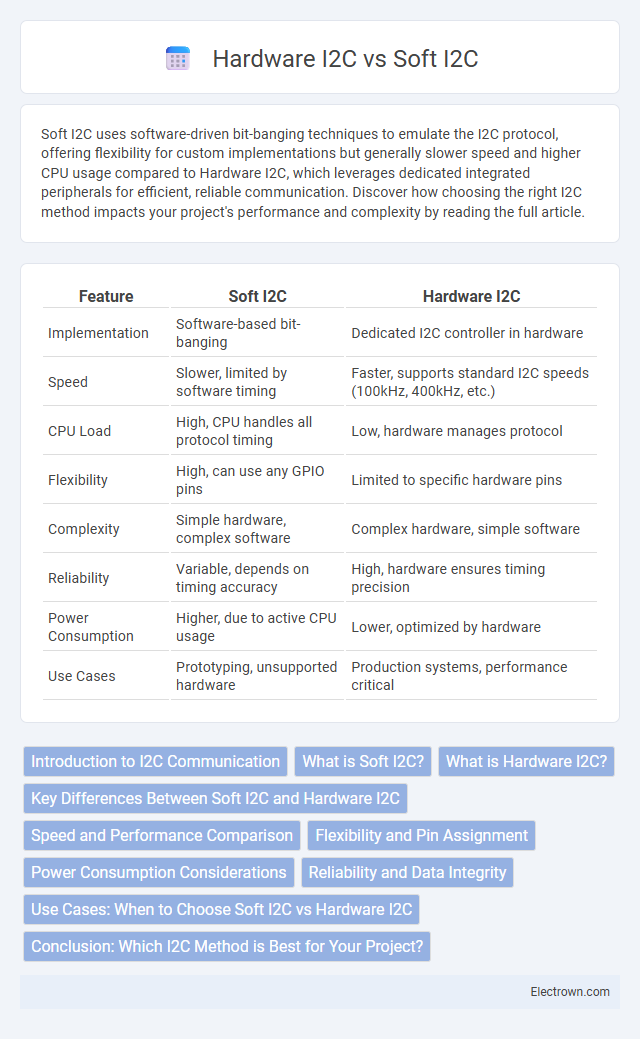Soft I2C uses software-driven bit-banging techniques to emulate the I2C protocol, offering flexibility for custom implementations but generally slower speed and higher CPU usage compared to Hardware I2C, which leverages dedicated integrated peripherals for efficient, reliable communication. Discover how choosing the right I2C method impacts your project's performance and complexity by reading the full article.
Table of Comparison
| Feature | Soft I2C | Hardware I2C |
|---|---|---|
| Implementation | Software-based bit-banging | Dedicated I2C controller in hardware |
| Speed | Slower, limited by software timing | Faster, supports standard I2C speeds (100kHz, 400kHz, etc.) |
| CPU Load | High, CPU handles all protocol timing | Low, hardware manages protocol |
| Flexibility | High, can use any GPIO pins | Limited to specific hardware pins |
| Complexity | Simple hardware, complex software | Complex hardware, simple software |
| Reliability | Variable, depends on timing accuracy | High, hardware ensures timing precision |
| Power Consumption | Higher, due to active CPU usage | Lower, optimized by hardware |
| Use Cases | Prototyping, unsupported hardware | Production systems, performance critical |
Introduction to I2C Communication
I2C communication is a widely used protocol that enables multiple devices to communicate over just two wires: SDA (data line) and SCL (clock line). Soft I2C, implemented via software bit-banging, offers flexibility for custom timing and pin selection but may result in slower performance and higher CPU usage compared to Hardware I2C, which uses dedicated microcontroller modules for faster, more efficient data transfer. Understanding the trade-offs between Soft and Hardware I2C helps optimize your design for speed, power consumption, and hardware resource constraints.
What is Soft I2C?
Soft I2C is a bit-banged implementation of the I2C protocol using general-purpose input/output (GPIO) pins instead of dedicated hardware modules, allowing greater flexibility in pin selection and timing control. Unlike hardware I2C, Soft I2C relies on software to manually toggle the clock and data lines, which can affect data transfer speed and CPU load. Your choice between Soft I2C and Hardware I2C depends on your project's requirements for hardware resources, timing precision, and processing overhead.
What is Hardware I2C?
Hardware I2C refers to the dedicated integrated circuit module within a microcontroller designed to handle Inter-Integrated Circuit communication protocols autonomously. It manages clock generation, data transmission, and synchronization via built-in registers, reducing CPU workload and ensuring precise timing control compared to software-driven methods. Hardware I2C typically offers higher reliability and faster communication speeds, making it ideal for complex or time-sensitive applications.
Key Differences Between Soft I2C and Hardware I2C
Soft I2C uses software-driven bit-banging to emulate the I2C protocol, offering flexibility in pin selection but higher CPU load and slower speeds compared to Hardware I2C, which relies on dedicated peripheral modules for efficient, high-speed communication. Hardware I2C supports advanced features like clock stretching and multi-master arbitration more reliably, while Soft I2C is limited by timing accuracy and increased software complexity. Your choice depends on system resources and performance needs, with Hardware I2C preferred for time-critical applications and Soft I2C suited for custom or resource-constrained designs.
Speed and Performance Comparison
Soft I2C implementation relies on software-driven timing, which often results in slower data rates and higher CPU usage compared to hardware I2C controllers that provide dedicated timing and signal generation. Hardware I2C supports faster communication speeds, typically up to 400 kHz or more, ensuring efficient data transfer with minimal processor intervention. Your application demands should prioritize hardware I2C for high-speed and reliable performance, especially in time-sensitive or multitasking environments.
Flexibility and Pin Assignment
Soft I2C offers greater flexibility in pin assignment as it allows you to configure any general-purpose I/O pins for SDA and SCL lines, making it ideal for custom hardware layouts or when hardware I2C pins are limited. Hardware I2C, however, uses dedicated pins optimized for speed and reliability but restricts you to specific pins fixed by the microcontroller's architecture. Your choice depends on whether you prioritize flexible pin usage or the performance advantages of built-in hardware I2C controllers.
Power Consumption Considerations
Soft I2C typically consumes more power than Hardware I2C due to software-based signal generation requiring continuous CPU intervention and longer active processing periods. Hardware I2C modules offload communication tasks to dedicated peripherals, minimizing CPU load and enabling lower overall power consumption, especially in low-power embedded systems. Efficient power management in embedded devices often favors Hardware I2C for prolonged battery life and optimized energy utilization.
Reliability and Data Integrity
Hardware I2C offers superior reliability and data integrity by utilizing dedicated microcontroller peripherals that handle clock stretching, arbitration, and error checking in real-time. Soft I2C relies on software bit-banging, which can introduce timing inconsistencies and increase the risk of data corruption, especially in high-speed or multitasking environments. You should choose hardware I2C for critical applications where consistent timing and robust error detection are essential to maintain flawless communication.
Use Cases: When to Choose Soft I2C vs Hardware I2C
Soft I2C is ideal for microcontrollers with limited hardware I2C ports or when customized timing and flexible pin assignments are required, such as in prototype development or non-standard I2C bus speeds. Hardware I2C offers lower CPU utilization, better speed, and higher reliability, making it suitable for production systems where consistent performance and power efficiency are critical. You should choose Soft I2C when hardware resources are constrained or require customization, and Hardware I2C when system stability and efficiency are priorities.
Conclusion: Which I2C Method is Best for Your Project?
Choosing between Soft I2C and Hardware I2C depends on project requirements such as speed, resource availability, and complexity. Hardware I2C offers faster communication and reliable timing with dedicated microcontroller modules, making it ideal for high-performance or real-time applications. Soft I2C provides flexibility and ease of implementation on limited hardware but may suffer from slower speeds and timing inaccuracies, suitable for simpler or prototype projects.
Soft I2C vs Hardware I2C Infographic

 electrown.com
electrown.com